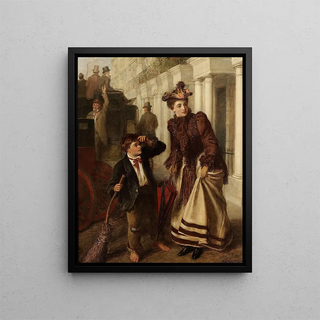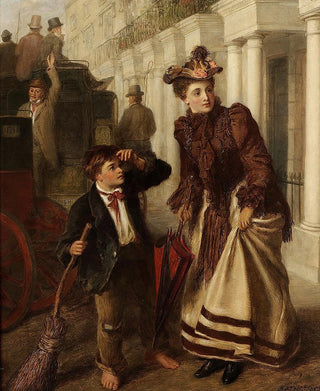Art print | The passerby street sweeper - William Powell Frith


View from behind

Frame (optional)
In the panorama of Victorian art, the "Art print The Passage Sweeper" by William Powell Frith stands out for its ability to capture everyday life with an almost photographic accuracy. This painting, created in 1858, depicts a fleeting moment in urban life, where the sweeper, a humble background character, is at the heart of a vibrant scene of London society. The work is not merely a simple representation; it invites the viewer to explore the nuances of city life, to feel the buzz of a rapidly changing era. Frith, through his talent, manages to transform a mundane moment into a profound reflection on the human condition.
Style and uniqueness of the work
Frith's style is characterized by meticulous realism, expressed through striking details and a carefully chosen color palette. In "The Passage Sweeper," every element, from the cobblestones to the faces of passersby, is treated with remarkable attention. Frith excels in the art of juxtaposing social classes, illustrating a society where destinies intertwine, often without notice. The sweeper, a central figure, embodies the dignity of the worker, while the bourgeoisie in the background seem absorbed in their concerns, indifferent to the life unfolding before their eyes. This dichotomy between the ordinary and the extraordinary, the visible and the invisible, gives the work an emotional depth that still resonates today.
The artist and his influence
William Powell Frith, an emblematic figure of the realist movement, established himself as a keen observer of his time. His ability to document everyday life while infusing it with emotional charge makes him a pioneer in the art of storytelling through painting. Frith was also a passionate advocate for the representation of the working class, a bold choice at a time when art was often dominated by historical or mythological subjects. His influence extends beyond his era, inspiring generations of artists to explore stories of ordinary life. Through his works, he

Matte finish

View from behind

Frame (optional)
In the panorama of Victorian art, the "Art print The Passage Sweeper" by William Powell Frith stands out for its ability to capture everyday life with an almost photographic accuracy. This painting, created in 1858, depicts a fleeting moment in urban life, where the sweeper, a humble background character, is at the heart of a vibrant scene of London society. The work is not merely a simple representation; it invites the viewer to explore the nuances of city life, to feel the buzz of a rapidly changing era. Frith, through his talent, manages to transform a mundane moment into a profound reflection on the human condition.
Style and uniqueness of the work
Frith's style is characterized by meticulous realism, expressed through striking details and a carefully chosen color palette. In "The Passage Sweeper," every element, from the cobblestones to the faces of passersby, is treated with remarkable attention. Frith excels in the art of juxtaposing social classes, illustrating a society where destinies intertwine, often without notice. The sweeper, a central figure, embodies the dignity of the worker, while the bourgeoisie in the background seem absorbed in their concerns, indifferent to the life unfolding before their eyes. This dichotomy between the ordinary and the extraordinary, the visible and the invisible, gives the work an emotional depth that still resonates today.
The artist and his influence
William Powell Frith, an emblematic figure of the realist movement, established himself as a keen observer of his time. His ability to document everyday life while infusing it with emotional charge makes him a pioneer in the art of storytelling through painting. Frith was also a passionate advocate for the representation of the working class, a bold choice at a time when art was often dominated by historical or mythological subjects. His influence extends beyond his era, inspiring generations of artists to explore stories of ordinary life. Through his works, he






